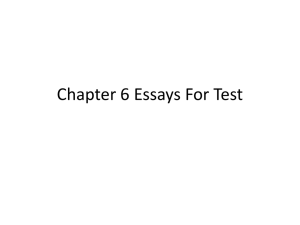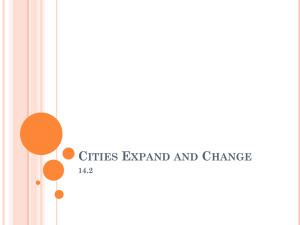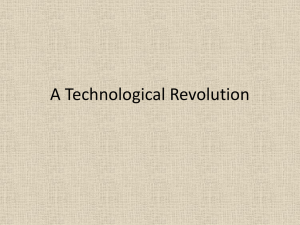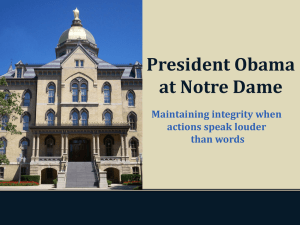The Historical Development of Mass Schooling
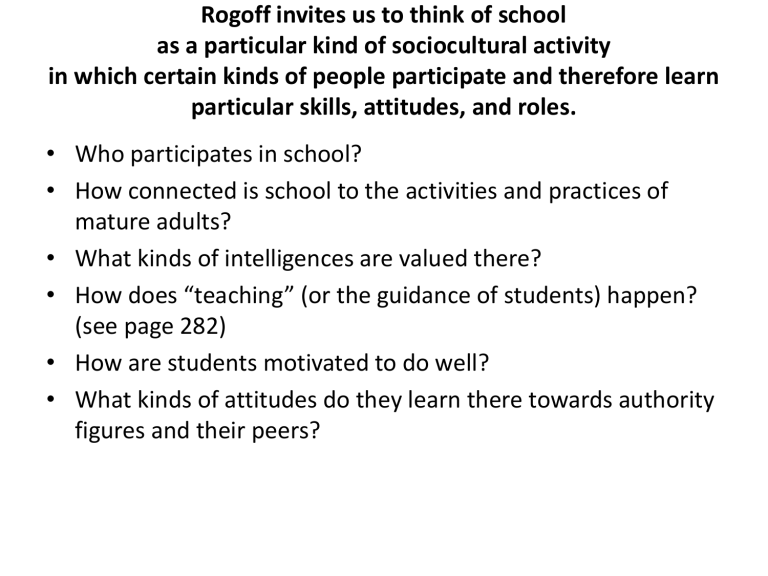
Rogoff invites us to think of school as a particular kind of sociocultural activity in which certain kinds of people participate and therefore learn particular skills, attitudes, and roles.
• Who participates in school?
• How connected is school to the activities and practices of mature adults?
• What kinds of intelligences are valued there?
• How does “teaching” (or the guidance of students) happen?
(see page 282)
• How are students motivated to do well?
• What kinds of attitudes do they learn there towards authority figures and their peers?
Childhood is a social identity that limits some roles and allows for others.
What does schooling say about our society’s view of childhood?
Peasant households where work is embedded in the household
Pieter Breughel c. 1525-1575,
“The Return of the Herd,” 1565
What happened before mass schooling?
Blacksmithing
Miniature from Chirurgia, by
Gerard of Cremona12 th century
Schools in the Middle Ages in Europe
• Schools independent from each other, each organized by a particular teacher
• Lack of gradation of the curriculum
• Mixing of students of different ages: ten year olds might sit with twenty year olds
Madrassa in Pakistan
Mass education was a product of nationalism
• Prussia, early 1800s; England and France, late
1800s: dependent on the relationship between political elite, upper classes, and the
Church
• Industrial working class and rural peasantry expected to go to school for a few years only
• Upper levels of schooling monopolized by landowners and the topmost layers of the merchant and professional classes
•
Dame schools
• Writing schools
• English schools
• Academies
• Monitorial schools
A “dame school,” 1856 in the UK
A monitorial school, invented by John Lancaster (1778-1838)
Educational Reforms of the 19
th
century
Horace Mann, 1796-1859
“Let the common school be expanded in its capabilities, let it be worked with the efficiency of which it is susceptible, and ninetenths of the crimes in the penal code would be obsolete; the long catalogue of human ills would be abridged; men would walk more safely by day; every pillow would be more inviolable by night; property, life, and character held by a stronger tenure; all rational hopes respecting the future brightened.”
Schools as a Public Good
• By the 1860s, most
Americans saw schools as a public good: something that would benefit society as a whole
• Concerns about democracy
• Fears about new immigrants Children at Ellis Island, c. 1908
Public Schools in the South, 1860s
“The first great movement for public education at the expense of the state in the South came from Negroes. Many white leaders before the war had advocated general education for white children but few had been listened to.
Schools for indigents and pauper white children were supported here and there and more or less spasmodically. Some states had elaborate plans but they were not carried out. Public education for all at public expense was, in the
South, a Negro idea.”
---W. E. B. DuBois
Centuries of Childhood: A Social History of
Family Life, by Philippe Ariès (1962)
• Ariès was a French social historian: interested in changes in ideas and practices as ordinary people experienced them
• Mass education developed alongside a new view of children
Philippe de Champaigne
“The Habert de Montmort Children” (1649)
Jan Steen, “A School for Boys and Girls” c. 1670
Mass education was a product of nationalism
• Prussia, early 1800s; England and France, late
1800s: dependent on the relationship between political elite, upper classes, and the
Church
• Industrial working class and rural peasantry expected to go to school for a few years only
• Upper levels of schooling monopolized by landowners and the topmost layers of the merchant and professional classes
•
Dame schools
• Writing schools
• English schools
• Academies
• Monitorial schools
A “dame school,” 1856 in the UK
A monitorial school, invented by John Lancaster (1778-1838)
Educational Reforms of the 19
th
century
Horace Mann, 1796-1859
“Let the common school be expanded in its capabilities, let it be worked with the efficiency of which it is susceptible, and ninetenths of the crimes in the penal code would be obsolete; the long catalogue of human ills would be abridged; men would walk more safely by day; every pillow would be more inviolable by night; property, life, and character held by a stronger tenure; all rational hopes respecting the future brightened.”
Schools as a Public Good
• By the 1860s, most
Americans saw schools as a public good: something that would benefit society as a whole
• Concerns about democracy
• Fears about new immigrants Children at Ellis Island, c. 1908
Public Schools in the South, 1860s
“The first great movement for public education at the expense of the state in the South came from Negroes. Many white leaders before the war had advocated general education for white children but few had been listened to.
Schools for indigents and pauper white children were supported here and there and more or less spasmodically. Some states had elaborate plans but they were not carried out. Public education for all at public expense was, in the
South, a Negro idea.”
---W. E. B. DuBois
